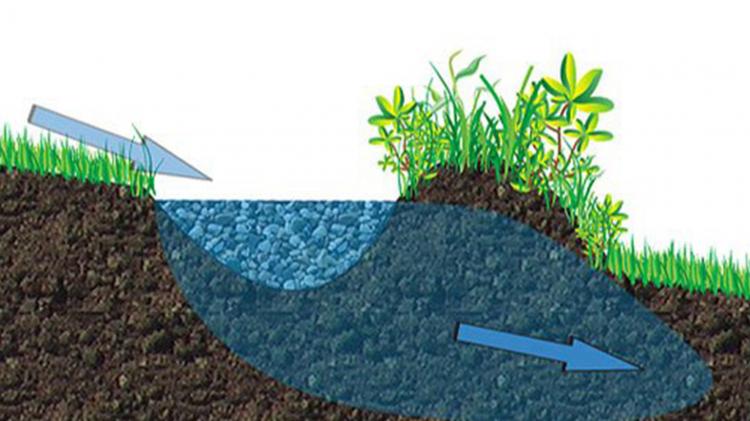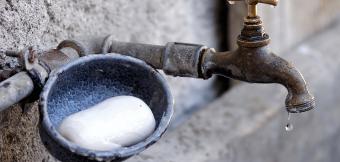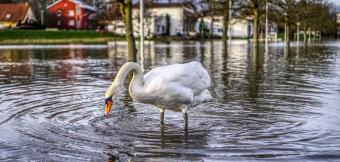
Manage water in the landscape
A big effect of climate change is unpredictable rainfall, causing both droughts and floods. This is an acute threat to crops and livelihoods. Adapt by improving how you collect and store water on your land. Slow it down and harvest it with ponds, tanks, wetlands, swales and trees.
Adapted from Andrew Millison, Permaculture Design Tools for Climate Resilience
Assess your risks
An historical survey of the last century should reveal local risks from floods and droughts (though bear in mind that many places are seeing unprecedented extremes). Assess your site to work out where water collects and moves through the site, and where is at risk from flooding or drying out. Recent experience may guide you. What is the watershed of your site? What are the impermeable surfaces and places where water is running off? Where does water enter and leave the site? Where can water be slowed, spread, sunk and stored?
Designing for drought
Drought is a slow motion disaster; it builds as rains fail, heat increases, and supplies are exhausted. It may last for one year but will often last for several, with each year worse than the one before.
This list of simple drought resilience strategies provides a design checklist for a drought mitigation plan:
- Save surplus to get you through bad times. Stockpile surplus water, food, seeds, or money. Remember in a good year (or season) that drought is likely to return, and store or invest accordingly.
- Store water from all precipitation and surface flows in ponds, tanks and wetlands. Swales, ditches, hedges and mulched areas built along contours will hold moisture on site.
- Reduce irrigation using pumped up groundwater. If the hydrologic cycle is broken, then pumping deep groundwater can deplete aquifers and degrade water resources.
- Reduce crops requiring frequent irrigation. Water intensive crops are being grown in places that do not have the long term water resources to support those crops.
- Reduce soil erosion and build soil health. The healthier and deeper the soil, the more water it can hold. Enhance the water holding capacities of soil to improve productivity and structure, and reduce the need for tillage and aeration. A healthy soil biology will accomplish all these things.
- Reduce bare soil surfaces. Covered soil is more biologically active, and can thus hold more moisture. Soil that is exposed to the sun, wind, and falling raindrops is more prone to erosion and dehydration.
- Cultivate tree products. Perennials are more resilient to yearly fluctuations of water availability because of their established root systems, especially if those trees, shrubs, herbs and grasses are climatically appropriate species.

Designing for torrential rain
Unpredictable and extremely heavy rain events are becoming more common. Resulting floods are a fast motion disaster that can can destroy crops, houses and livestock and cause catastrophic soil erosion. Flooding can be managed through several strategies:
- Harvest water as it passes through the site in ponds, tanks and marshy areas. Overflows on water harvesting structures should be robust and sized for large scale rain events.
- Water flow within ploughed fields should be channelized so flood flow does not spread out within fields and damage crops and soils.
- Outside of ploughed fields, the passage of water should be slowed as much as possible through the building of permeable dams, meanders, overflow ponds and the creation of marshes, flood meadows and wooded areas.
- Water flows can be brought into a field at the embankment at the bottom of the field, so water can back flood into the field, avoiding damaging flows across the field.
- Man-made channels will help direct water. Swales, ditches and mulched areas built along contours will catch and hold water safely, while ditches running down the slope will carry it to a stream or storage area.
- Field drains should be mapped, cleaned and improved. But don't use them to direct water off the site, send it to a storage point instead.
- Plantings of trees will slow water flow, take up excess water, catch washed away nutrients, and stabilise soil against erosion.
Watershed level planning
True resilience does not happen within the boundaries of one site. It happens by planning at the scale of communities and regions. Water harvesting structures need to be interlinked between farms and villages, and there needs to be a recognition that upstream is intimately linked to downstream; too much water harvesting upstream can lead to drought downstream, too little water capture can lead to flooding. The perspective that needs to be adopted is water resource development at the watershed scale.
Another important aspect of restoring the hydrologic cycle and stabilizing the climate is reforestation. Trees and shrubs can provide food security, and forests help to increase rainfall by transpiring water into the atmosphere which produces precipitation.
Picture credits: 1)Permaculture Association 2) Icon0.com/Pexel 3) Adrian Buckley - http://permaculture.org.au/2010/05/20/water-harvesting-and-storage/
Install a water barrel or tank to harvest rainwater from your roof
Introduce a phased programme of water harvesting features
Campaign for greater government awareness about climate risks
Support a charity that improves clean water supply in the developing world



